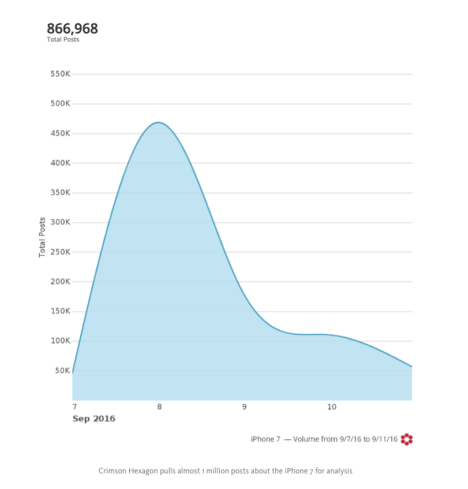iPhone 7: how the internet reacted to Apple pulling the headphone plug
Apple’s changes to the iPhone 7 created social media mayhem this week. Social analyst Brodie Evans breaks down what happened following the announcement.
An eventful week in the world of big tech with Apple announcing they are cutting ties with the 3.5 mini-jack in their new iPhone7, in favour of the proprietary lightning connector and wireless earbuds.
The reaction across social media was immediate, fierce and highly emotional. Given just how emotionally-charged the conversation is, you would be forgiven for thinking a different sort of plug was being pulled.
Across the public social data, we can see almost 1 million posts make up the conversation in the four days since the announcement.



One notable shift in analytics is the increasing demand for actionable intelligence, not more data. This falls in the latter category.
Data without context is noise. The utility of vanity metrics even when dressed up in beautiful charts is limited. There is real value to be extracted from social data but not at this level.
The real value for brands and marketers comes from being able to ask the right questions – who, what, where, when and why…and for that you need a more powerful tool.
It’s of limited value to know there were 866k posts, that saddness was a featured emotion and that 12k mentioned “courage”. The value lies in understanding and quantifying what impact the removal of jacks will have on the brand, loyalty, sales, competitors and experience.
This is where the market is going….turning data in to intelligence
Hi Patrick
I completely agree with the point you’re making, but this article was written to provide a top-level overview of emotion in the social conversation. I wanted to see how emotion played a role in the social conversation, not forecast/measure brand impact.
If I wanted to dive deeper into brand impact, competitor analysis and customer experience (etc), I would train the Crimson Hexagon algorthim to breakdown the conversation in individual analysis monitors, then compile my results at the end into a comprehensive case study. If you would like to commission such a study, feel free to get in touch!
Social data provides insight into unsolicited opinions being expressed online, and can be a powerful tool to educate understanding of consumer reaction. I would never claim it is a solve-all solution for brand impact insights, but used in conjunction with other market research methods it is worthy analysis and shouldn’t be ignored.